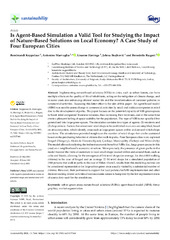| dc.description.abstract | Implementing nature-based solutions (NBSs) in cities, such as urban forests, can have
multiple effects on the quality of life of inhabitants, acting on the mitigation of climate change, and
in some cases also enhancing citizens’ social life and the transformation of customer patterns in
commercial activities. Assessing this latter effect is the aim of this paper. An agent-based model
(ABM) was used to assess change in commercial activities by small and midsize companies in retail
due to the development of parks. The paper focuses on the potential capacity of NBS green spaces
to boost retail companies’ business volumes, thus increasing their revenues, and at the same time
create a pleasant feeling of space usability for the population. The type of NBS is not specified but
generalized into large green spaces. The simulation contains two types of agents: (1) residents and
(2) shop owners. Factors that attract new retail shops to be established in an area are simplified, based
on attractor points, which identify areas such as large green spaces within and around which shops
can form. The simulations provided insights on the number of retail shops that can be sustained
based on the purchasing behavior of citizens that walk in parks. Four European cities were explored:
Szeged (Hungary), Alcalá de Henares (Spain), Çankaya Municipality (Turkey) and Milan (Italy).
The model allowed analyzing the indirect economic benefit of NBSs (i.e., large green spaces in this
case) on a neighborhood’s economic structure. More precisely, the presence of green parks in the
model boosted the visits of customers to local small shops located within and around them, such as
cafés and kiosks, allowing for the emergence of 5–6 retail shops (on average, for about 800 walking
citizens) in the case of Szeged and an average 12–14 retail shops for a simulated population of
2900 persons that walk in parks in the case of Milan. Overall, results from this modeling exercise can
be considered representative for large urban green areas usually visited by a substantial number of
citizens. However, their pertinence to support for local policies for NBS implementation and other
decision-making related activities of socioeconomic nature is hampered by the low representativeness
of source data used for the simulations. | sr |

